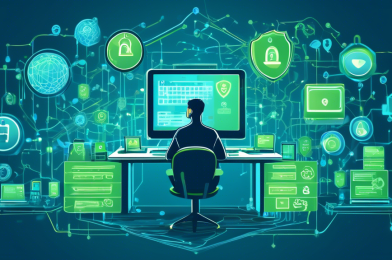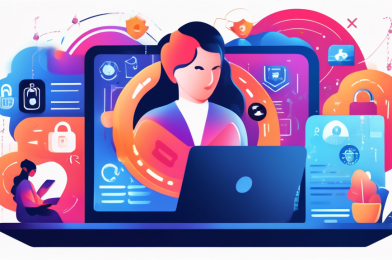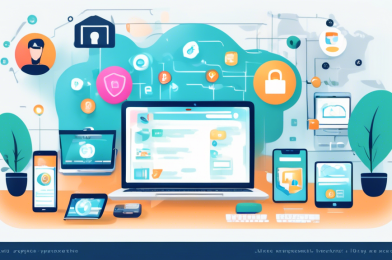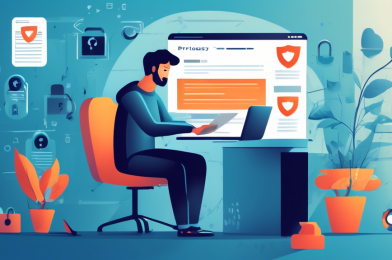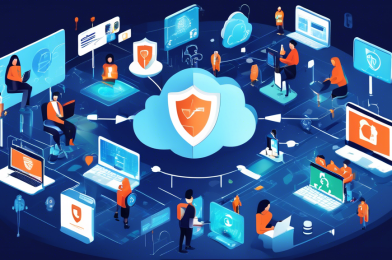Comprehensive Overview: Why You Need the Best Internet Privacy Tools
In today’s interconnected world, internet privacy has become a cornerstone of digital life. As we share more of our personal information online, the importance of protecting that data grows exponentially. The digital age brings with it a myriad of benefits, but also an array of potential cyber threats that can compromise your privacy and security. From identity theft to data breaches, the risks are numerous and ever-evolving.
This is where the best internet privacy tools come into play. By leveraging top-notch privacy tools, you can safeguard your information against malicious actors and maintain control over your personal data. Whether you’re browsing the web, communicating through encrypted messaging apps, or utilizing virtual private networks (VPNs), these tools offer robust protection against a wide spectrum of digital vulnerabilities. Embracing the best internet privacy tools is not just a precautionary measure; it’s a critical step towards ensuring your online safety and peace of mind.
Comprehensive Overview: Why You Need the Best Internet Privacy Tools
Importance of Internet Privacy in the Digital Age
The digital age has revolutionized the way we live, work, and communicate. While the internet offers a myriad of benefits, it also poses significant risks to our personal data and privacy. In an era where information is the new currency, safeguarding your online privacy has never been more critical. The best internet privacy tools are essential in protecting your sensitive data from prying eyes, ensuring that your online activities remain confidential.
With each click, every social media post, and each online transaction, we leave behind a footprint. Cybercriminals and even legitimate organizations often exploit this data for various purposes, from targeted advertising to more malicious intents like identity theft. This growing data vulnerability makes it imperative to leverage robust internet privacy tools to keep your personal information secure.
Growing Cyber Threats and How They Impact Personal Data
The digital landscape is fraught with numerous cyber threats that can compromise your privacy. Cyber-attacks have become more sophisticated, making it easier for malicious actors to intercept and misuse your data. Here are some prevalent cyber threats that highlight the importance of the best internet privacy tools:
- Phishing Attacks: Cybercriminals deceive users into revealing personal information or login credentials through fake websites or emails.
- Ransomware: This malware encrypts a user’s data and demands payment for the decryption key, posing a severe threat to privacy and financial security.
- Data Breaches: Organizations collecting vast amounts of personal data are prime targets for breaches, which can lead to the exposure of sensitive information.
- Man-in-the-Middle Attacks: Attackers intercept and potentially alter communication between two parties without their knowledge, jeopardizing the privacy of the information exchanged.
- Spyware: Malicious software installed on your device to collect information about your activities without your knowledge.
These threats are not just hypothetical scenarios; they happen every day, affecting millions of users worldwide. Employing the best internet privacy tools is a proactive step in mitigating these risks and enhancing your online security.
Benefits of Using Top-Notch Privacy Tools to Safeguard Your Information
Investing in the best internet privacy tools offers numerous advantages, ensuring that your personal data remains protected across various online interactions. Some of the key benefits include:
- Enhanced Security: Top privacy tools provide advanced encryption methods, making it significantly harder for unauthorized parties to access your data.
- Anonymous Browsing: Tools like Virtual Private Networks (VPNs) allow you to mask your IP address, making it difficult for third parties to track your online activities.
- Data Integrity: By using internet privacy tools, you can prevent tampering and ensure that your data remains accurate and intact.
- Protection from Malicious Attacks: Privacy tools can identify and block potential threats before they compromise your system, offering a robust defense against malware and other cyber-attacks.
- Regaining Control Over Personal Info: By encrypting your communications and data, you retain control over who has access to your personal information.
- Peace of Mind: Knowing that your personal data is protected allows you to browse and interact online without constantly worrying about potential threats.
The importance of internet privacy cannot be overstated in today’s interconnected world. By utilizing the best internet privacy tools, you not only protect your personal data but also enhance your overall online experience. These tools are not just optional add-ons but essential components of a comprehensive digital security strategy. In the subsequent sections, we will delve into the top picks for the best internet privacy tools of 2023 and provide guidance on selecting the right tools for your needs.
Top Picks for the Best Internet Privacy Tools of 2023
Detailed Reviews of Highly-Rated VPNs (Virtual Private Networks)
When it comes to the best internet privacy tools, VPNs have rightfully earned their place at the top of the list. Virtual Private Networks (VPNs) create an encrypted tunnel between your device and the internet, ensuring that your online activities remain private and secure. Let’s take a closer look at some of the highly-rated VPNs for 2023.
-
ExpressVPN
ExpressVPN is celebrated for its exceptional security features and high-speed connections. It boasts a vast network of servers in over 90 countries, allowing users to mask their IP addresses effectively. With robust encryption and a strict no-logs policy, ExpressVPN ensures that your browsing data remains confidential. Additionally, it offers easy-to-use apps for all major platforms, making it accessible for everyone.
-
NordVPN
Another stellar option, NordVPN, is known for its double encryption feature, which adds an extra layer of security. With over 5,000 servers globally, NordVPN provides fast and reliable connections. It includes features like CyberSec, which blocks ads and malicious websites. NordVPN’s commitment to privacy is reinforced by its independent audits and a strong no-logs policy.
-
CyberGhost
CyberGhost is a user-friendly VPN service that offers excellent privacy protection. It covers over 7,000 servers in 90 countries, making it perfect for accessing restricted content worldwide. CyberGhost is transparent about its operations, publishing regular transparency reports and adhering to a strict no-logs policy. The automatic kill switch and robust encryption ensure your data stays secure, even if the connection drops.
Analysis of Leading Encrypted Messaging Apps
Encrypted messaging apps are indispensable for preserving the privacy of your communications. They use end-to-end encryption to ensure that only the intended recipient can read your messages. Here are the leading encrypted messaging apps of 2023:
-
Signal
Signal is often hailed as the gold standard for encrypted messaging. Developed by the non-profit Signal Foundation, it offers end-to-end encryption for text messages, voice calls, video calls, and file transfers. Signal’s code is open-source, allowing independent experts to verify its security. With features like disappearing messages and screen security, Signal is designed to protect your privacy rigorously.
-
WhatsApp
Owned by Facebook, WhatsApp remains a popular choice for encrypted messaging. It provides end-to-end encryption for all communications, ensuring that messages can only be read by the sender and receiver. WhatsApp also supports voice and video calls, group chats, and multimedia sharing with the same level of encryption. Its widespread use makes it a convenient option for secure messaging.
-
Telegram
Telegram offers a variety of features alongside its encryption technology. While its cloud chats are encrypted, its secret chats employ end-to-end encryption for maximum privacy. Telegram includes features like self-destructing messages, large file sharing, and encrypted voice calls. Its open API and source code transparency aid in building user trust.
Evaluation of Effective Browser Extensions and Tools for Online Anonymity
Maintaining anonymity while browsing is crucial in protecting your online identity from prying eyes. Various browser extensions and tools can significantly enhance your privacy. Here are some of the best picks for 2023:
-
uBlock Origin
uBlock Origin is a highly effective ad and content blocker that prevents intrusive ads, trackers, and malicious websites from loading. It is lightweight, ensuring that your browser remains fast. uBlock Origin offers extensive filtering options, giving users control over what elements to block. Its open-source nature ensures constantly updated and community-vetted protection.
-
Privacy Badger
Developed by the Electronic Frontier Foundation, Privacy Badger automatically blocks trackers that violate the principle of user consent. Unlike traditional ad blockers, Privacy Badger learns to block invisible trackers based on user behavior, improving its efficiency over time. This extension is an excellent choice for protecting your browsing habits from being monitored.
-
DuckDuckGo Privacy Essentials
DuckDuckGo Privacy Essentials is a comprehensive browser extension offering private search, tracker blocking, and site encryption enhancements. By limiting the amount of data corporations can collect about you, it ensures a higher degree of anonymity. Integrated with DuckDuckGo’s private search engine, this extension provides a streamlined browsing experience free from privacy invasions.
In conclusion, the best internet privacy tools of 2023—from powerful VPNs and encrypted messaging apps to effective browser extensions—equip you with the means to safeguard your data. These tools collectively contribute to a secure, private, and anonymous online experience, essential in today’s digital age.
How to Choose the Best Internet Privacy Tools for Your Needs
Key Features to Look for in Privacy Tools
Choosing the best internet privacy tools can seem daunting with the vast array of options available. However, understanding the key features to look for can make this task easier and ensure that you select a tool that effectively safeguards your data.
Encryption: The core of any privacy tool should be its encryption capability. End-to-end encryption ensures that only you and the person you’re communicating with can read what is sent. Look for tools that use strong encryption standards like AES-256.
Usability: Even the most secure tools are useless if they are too complicated to use. Make sure the privacy tool you choose has a user-friendly interface and does not require extensive technical knowledge.
Transparency: Transparency is crucial in understanding how a tool handles your data. Opt for tools with open-source code, as this allows independent security audits and ensures that there are no hidden vulnerabilities.
No-logs Policy: Especially for VPNs, a no-logs policy means the company does not keep any records of your activities. This policy is vital for maintaining your privacy and ensuring that even if data requests are made, there is nothing to hand over.
Multi-Platform Support: Your chosen privacy tools should work across all your devices. Whether you use a smartphone, tablet, or computer, consistent security measures across all platforms are necessary to maintain privacy.
Comparing Free Versus Paid Solutions
The choice between free and paid privacy tools often boils down to the balance of cost versus functionality. Free options can be tempting, but they often come with limitations and potential risks.
Free Tools: While free privacy tools are accessible and budget-friendly, they often come with compromises. They may include limited features, lower-quality service, or ads that can intrude on your browsing experience. Additionally, the revenue models of some free tools may rely on selling user data, which directly contradicts the primary goal of privacy.
Paid Tools: Paid privacy solutions generally offer more comprehensive features, better performance, and customer support. These tools are less likely to compromise your data security as their revenue model does not rely on advertising or selling user data. The investment in a paid tool often translates to enhanced security, advanced features, and regular updates.
Ultimately, if you handle sensitive information or require robust security, investing in a paid privacy tool is advisable. However, for casual users, free tools can be sufficient if chosen carefully, ensuring they meet the essential privacy criteria.
Tips for Integrating These Tools into Your Daily Digital Activities
After selecting the best internet privacy tools, it’s important to integrate them seamlessly into your daily digital routines. Here are some practical steps to maximize their benefits:
Regular Updates: Always keep your privacy tools updated. Developers constantly release updates to fix vulnerabilities and enhance security features. Automate updates where possible to ensure you’re protected with the latest security patches.
Consistent Use: Make it a habit to use your privacy tools consistently. For example, always activate your VPN when browsing the internet, especially on public Wi-Fi. Consistency ensures your data remains protected at all times.
Educate Yourself: Stay informed about the latest privacy threats and best practices. Regularly reading articles and security bulletins can provide insights into new risks and how to mitigate them.
Custom Settings: Take the time to customize the settings of your tools. Default settings may not always offer the highest level of security. Adjust configurations to match your specific privacy needs.
Use Strong Passwords: Complement your privacy tools with strong, unique passwords for different accounts. Employ password managers to handle complex passwords easily and securely.
Enable Two-Factor Authentication (2FA): Whenever available, enable 2FA. This adds an additional layer of security, significantly reducing the risk of unauthorized access.
Back Up Data: Regularly back up important data using encrypted backup solutions. This ensures that you can restore your information safely in case of data loss from a cyber incident.
By focusing on the key features, understanding the trade-offs between free and paid tools, and following these integration tips, you can effectively enhance your online security and privacy. Selecting and properly using the best internet privacy tools will help protect your data from increasing cyber threats and maintain your digital integrity.
Conclusion: Securing Your Digital Future
As we’ve explored, the digital landscape continues to evolve, bringing with it both unprecedented opportunities and significant risks. The growing threat of cyber-attacks and the constant influx of data breaches underscore the necessity of employing the best internet privacy tools available. Whether you’re protecting personal communications with encrypted messaging apps, securing your online presence with a robust VPN, or utilizing browser extensions designed for anonymity, these tools are indispensable in safeguarding your digital life.
The Value of Vigilance
The importance of vigilance in protecting your data cannot be overstated. While the tools we’ve reviewed in 2023 offer top-notch protection, they are not a one-size-fits-all solution. It’s crucial to assess your unique needs, weigh the features of free and paid tools, and integrate these solutions seamlessly into your daily routine. By doing so, you can ensure that your online activities remain private and secure in an age where data is both a valuable asset and a potential liability.
Empowered Choices for Enhanced Privacy
Selecting the best internet privacy tools is ultimately about making empowered choices to protect yourself in a digital world. With an informed approach, you can navigate through the myriad of available options, select the tools that best suit your needs, and enjoy a more secure and private online experience. Remember, the right privacy tools not only safeguard your data but also grant you peace of mind, knowing that your personal information remains under your control.
Stay informed, stay protected, and embrace the tools that pave the way for a safer digital future.

